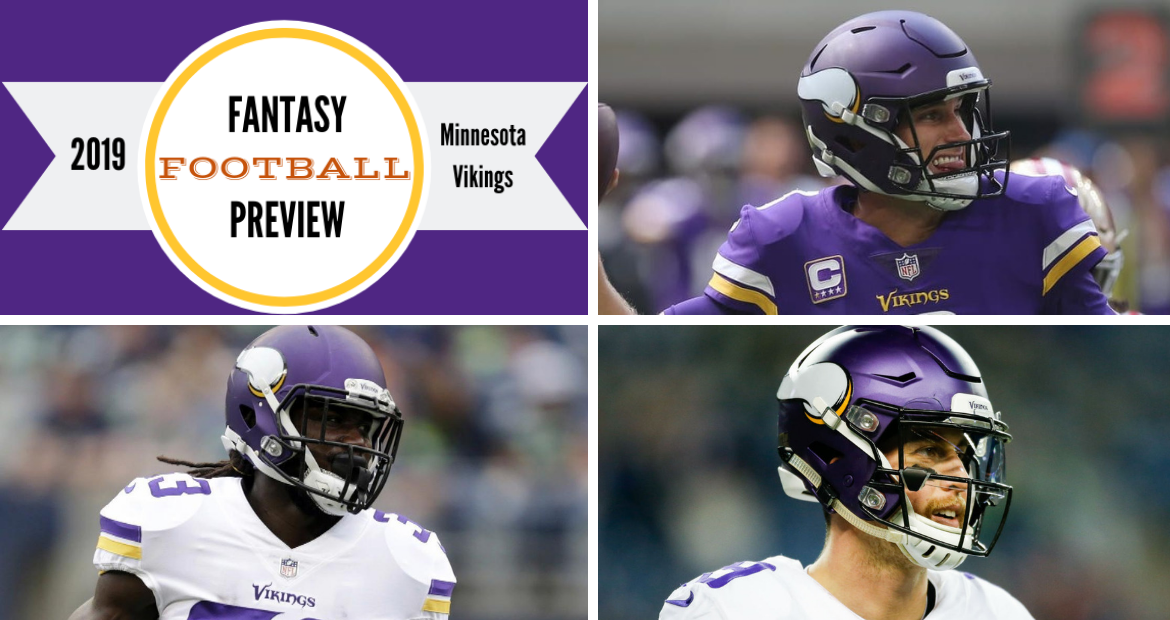
Fitz on Fantasy: 2019 Minnesota Vikings Fantasy Preview
With the preseason here, TFG fantasy expert Pat Fitzmaurice is breaking down the prospects for all 32 teams. Click here for a running list of teams, and check back often as teams are added on an almost daily basis. On to the Minnesota Vikings…
Most fantasy owners know that the conservative play-calling tendencies of Seattle offensive coordinator Brian Schottenheimer have tied an anchor to the fantasy value of Russell Wilson and some of the other contributors to the Seattle passing game. But the Vikings have sailed their wooden ships beneath the radars of many fantasy enthusiasts on their voyage back in time to claim Groundland for the Nordic people.
The Seahawks’ shift in offensive philosophy was evident throughout the 2018 season. The Vikings’ offensive sea change took place late in the year, so it went undetected by some. Offensive coordinator John DeFilippo was fired 13 games into the season (coincidentally, after a loss to the Seahawks). DeFilippo is a fairly well-respected play-caller, but the Minnesota offense had been sputtering in the second half of the season, and head coach Mike Zimmer apparently was perturbed that the Vikings hadn’t been running enough.
After quarterbacks coach Kevin Stefanski was promoted to interim offensive coordinator, the Vikings ran the ball on 50.3% of their offensive snaps over their last three games. Stefanski was retained as the OC, but he probably won’t have free rein with the offense since the Vikings brought in Gary Kubiak to serve in a nebulous “assistant head coach” role. Kubiak has long been known for his zone running scheme, which he’s orchestrated with success (mostly) in Houston, Baltimore and Denver. The Vikings’ defense is strong enough that they won’t be forced into shootouts very often, and Zimmer is still ultimately calling the shots, so expect the run-heavy focus to remain.
That bodes ill for the fantasy value of Kirk Cousins. In his first year as the Vikings’ QB, Cousins completed a career-best 70.1% of his throws for 4,298 yards, with 30 TDs and 10 INTs, and finished QB13 in fantasy points. Under DeFilippo, Cousins averaged 37.4 pass attempts per game; under Stefanski, he averaged 27.3 pass attempts per game. Cousins is efficient enough to manage a balanced (read: run-heavy) offense, but if that is indeed his role this year, it’s probably not going to result in sexy fantasy numbers, even if he has arguably the best WR tandem in the league.
If there’s such a thing as a clutch gene, Cousins isn’t a carrier. In 25 starts against opponents with winning records, Cousins has led his teams to four wins. He’s 0-7 in Monday-night games, 5-13 in all prime-time games and 13-23-2 on the road. For fantasy football it’s largely irrelevant that Cousins rarely plays his best in his team’s toughest games. Maybe we shouldn’t be bothered by it. We really only care about the raw statistics Cousins produces. But maybe the good opponent/bad opponent performance disparity is a clue that Cousins isn’t as good as his numbers suggest.
Still, that’s only a secondary reason why I’m fading Cousins. It’s much more about the direction of the Minnesota offense. Cousins isn’t grossly overpriced as an ADP of QB19, but there are other guys in the mid-to-late QB2 range I’d rather have.
Vikings WRs Stefon Diggs and Adam Thielen typically come off the board within 10 spots of each other in drafts, and it’s been that way for a while. Last year, Diggs’ ADP was WR11; Thielen’s was WR14. This year, they’ve switched spots. Thielen is now coming off the board early in the third round, on average, while Diggs is going late in the third.
I happen to agree with the spread between the two players – I like Thielen a little more, mainly because he’s been far more durable – but there are some sharp people in the fantasy media who prefer Diggs. Trying to parse the difference between them seemed like a more important exercise last year. They’re both overpriced by about a half-round this year, so I’m not especially interested in either.
Thielen produced the best numbers of his career in 2018 – 113 catches for 1,373 yards and nine touchdowns, which made him the WR7 in half-point PPR formats. But after a torrid start, he fizzled down the stretch. Thielen cleared 100 yards in each of his first eight games. He also had a streak of six straight games with a TD catch. But over his last five outings, Thielen averaged four catches for 67 yards. Over his last three games, after Stefanski replaced DeFilippo, Thielen was targeted just 12 times and had 10 catches for 137 yards and no touchdowns.
Diggs also hit career highs across the board in 2018, with 102 catches for 1,021 yards and nine TDs, good for a WR10 finish. He had a TD catch in each of the three games Stefanski called at the end of the regular season, but after averaging 10.5 targets with DeFilippo calling the shots, Diggs averaged 7.7 targets and just 35.3 yards in Stefanski games.
Some might say a three-game sample is insignificant. I’m certainly not projecting these three-game target numbers for Thielen and Diggs over the entirety of the 2019 season. But the direction of this offense is pretty clear, and it seems as if these two receivers will be hard-pressed to return a profit on their ADPs if Minnesota’s newfound commitment to the running game sticks.
I have Thielen ranked WR15, Diggs WR17. I don’t think that’s TOO disrespectful, but it means I’m probably not going to have either of them on any of my teams.
The Vikings plowed a lot of capital into the TE position over the offseason. They grabbed Irv Smith Jr. in the second round of this year’s draft, then signed Kyle Rudolph to a four-year, $36 million extension.
Smith had 44 catches for 710 yards and seven touchdowns at Alabama last year. But as draft analyst Thor Nystrom of Rotoworld (@thorku) posited, defenses probably weren’t that worried about Smith when the Crimson Tide had so much otherworldly talent at all the skill positions. Nystrom is a Vikings fan and wasn’t crazy about the Smith selection. He wonders whether the 6-2, 242-pound Smith can be used as an in-line blocker, and he noted that Smith’s subpar burst and agility showed up on tape when he tried to separate from defenders. This is all moot, I suppose, because when the Vikings re-upped with Rudolph, any 2019 fantasy value Smith might have had was shivved in the back.
Rudolph had 64-634-4 last season to finish TE8 in fantasy scoring, but he was just TE15 in fantasy points per game. Rudolph looked even slower than usual last year, and Pro Football Focus graded him as an average blocker. So why did the Vikings back up the Brink’s truck for him? PFF’s Connor Price (@PFF_ConnorPrice) noted that Rudolph caught 16 of 20 late-down targets last year for 12 first downs, and Cousins had a passer rating of 124.8 throwing to Rudolph on late downs. The veteran tight end has also been effective in the red zone, Price noted, as Rudolph’s red zone targets over the last three seasons have netted a passer rating of 111.9.
But again, the Vikings’ probable run-heaviness darkens the fantasy outlook for all of their pass catchers, and the lumbering Rudolph appears overpriced even at a modest ADP of TE16.
It’s been a pretty grim fantasy forecast for the Minnesotans so far, dontcha know. But there’s reason to be enthusiastic about lead RB Dalvin Cook, who has a chance to be one of the NFL’s few true workhorse running backs.
The only concern with Cook is health. He was off to a terrific rookie start in 2017 when he tore his ACL in Week 4. A hamstring issue cost Cook five games early last year. But in the 15 NFL games he’s played so far, Cook has 1,365 yards from scrimmage and six touchdowns, with averages of 4.7 yards per carry and 7.7 yards per catch.
Cook has also averaged 17.2 touches per game over his first two seasons, and that seems like a reasonable expectation for the sort of workload he’ll have this year. The Vikings don’t have anyone who’s going to threaten Cook’s supremacy in this backfield, and Zimmer is hell-bent on establishing the run.
Kubiak’s zone running scheme should suit Cook’s game. Hell, it’s suited a lot of running backs over the years. Here’s an interesting nugget that Scott Smith (@SSmithFF) dug up for the PlayerProfiler.com Ultimate Draft Kit: In 22 seasons as either a coordinator or head coach, Kubiak’s lead RB has averaged 1,124 rushing yards, 256 receiving yards and 10.5 touchdowns.
Cook’s ADP is RB10, and I think that reflects some general skittishness over his recent injuries. I understand the concern, but the combination of talent and role should make Cook an early target. I have him ranked RB7 and have been scooping him up late in the first round or early in the second.
The other backs vying for roles are rookie Alexander Mattison and veterans Mike Boone and Ameer Abdullah. Mattison, a third-round draft pick, isn’t especially athletic but was an affective workhorse at Boise State who ran 302 times for 1,415 yards and 17 TDs in his final college season. I’m mildly interested in him as the probable No. 2 in this backfield and as a hedge against a Cook injury. Boone is faster and more athletic than Mattison but has a lesser pedigree as an undrafted free agent from Cincinnati entering his second year. Abdullah was a college star at Nebraska who hasn’t ever panned out in the NFL but still flashes a little bit of magic from time to time, usually in the preseason.
| PLAYER | FITZ RANK | ECR | ADP | ADVICE |
| Kirk Cousins | QB23 | QB18 | QB19 | You like that? |
| Dalvin Cook | RB7 | RB10 | RB10 | Worth it |
| Alexander Mattison | RB58 | RB63 | RB55 | Mildly interesting |
| Adam Thielen | WR15 | WR13 | WR11 | Fade |
| Stefon Diggs | WR17 | WR14 | WR14 | Fade |
| Kyle Rudolph | TE22 | TE17 | TE16 | No thanks |
ADP = Average Draft Position ECR = Expert Consensus Ranking (based on half-PPR scoring)



